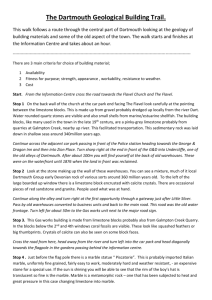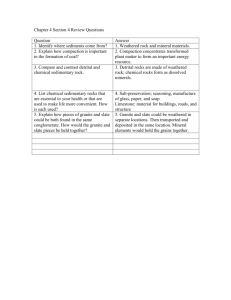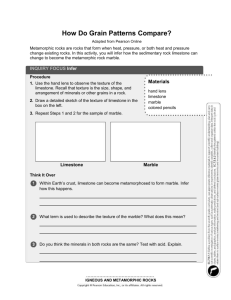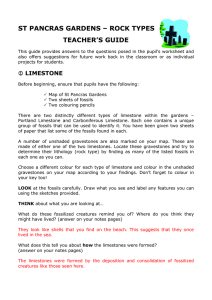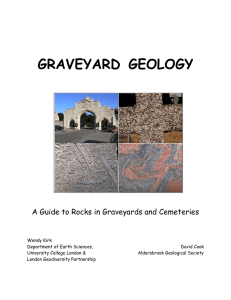File
advertisement
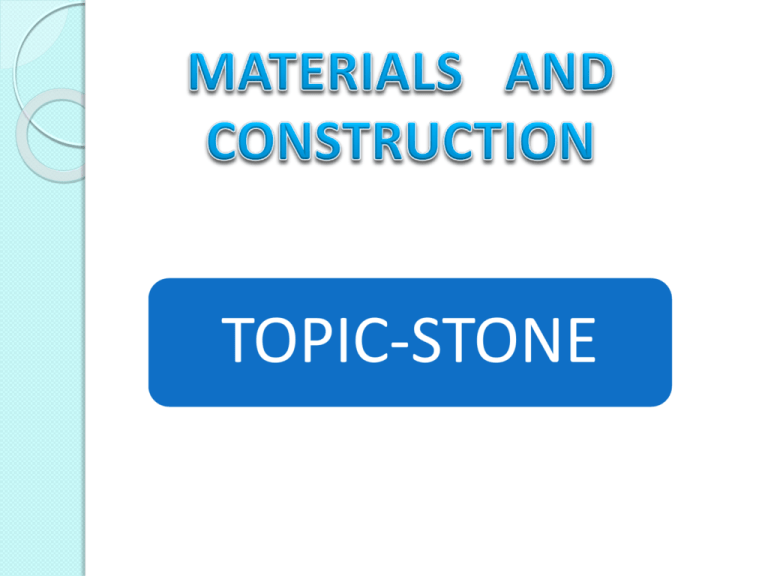
TOPIC-STONE GROUP MEMBERS 1 . SALONI DHIMMAR 2. AANAL SANKESARA 3. MAITRI SHAH 4. DIVYA PANDYA 5. MAHIMA SHAH STONE Properties of stone:- It is hard solid non metallic mineral matter of which rock is made especially as a building material. LIMESTONE DEFINITION Limestone is a sedimentary rock composed primarily of calcium carbonate (CaO3) in the form of the mineral calcite FORMATION It most clearly form in clear, warm, shallow marine waters. It is form from the accumulation of shell, coral, algae. WHERE IT IS FOUND Today Earth has many limestone forming environment. Most of them are found in shallow water areas between 30 degrees south latitude. It is found in Caribbean Sea, Indian ocean, Persian gulf, Gulf of Mexico. COMPOSTION Lime stone is by definition a rock that contains at least 50% calcium carbonate in the form of calcite by weight. It contains small material of quarts, feldspar clay minerals pyrite, siderite USES Limestone is a rock with an enormous diversity of uses. It could be the one rock that is used in more ways than any other. Most limestone is crushed and used as a construction material . It is used as crushed stone for road base Pyramid of giza Court house ADVANTAGES Elegance Carving Porous and soft DISADVANTAGES Very expensive Very heavy Difficult to maneuver COST Limestone can be fairly expensive to install. The materials usually cost between $3 to $10 per square foot and it is strongly recommended that it be installed by a professional as limestone very heavy and difficult to maneuver. GRANITE DEFINITION OF GRANITE Granite is common type of felsic intrusive igneous rock which is a granular and phaneritic in texture. COMMERCIAL GRANITE CHEMICAL CONTAINS Granite containing potassium feldspar , plagioclase feldspar , quarts and biottite and/ or amphibole minerals. It is the potassium feldspar that gives many granites a distinctive pink color. PHYSICAL PROPERTIES The average density of granite is between 2.65 and 2.75 g/cm3 Its copressive strength usually lies above 200mpa. Melting temprature is 1215-1263 C USES EXTERIOR USES:- Rough –cut and polished granite is used in buildings , bridges , paving , monuments. INTERIOR USES: Indoors polished granite slabs and tiles are used in counters , tile floors and decorative features. ORBICULAR GRANITE MOUNTRUSHMORE ADVANTAGES Granite is hard and tough Placing hot items or cutting on granite will never damage the surface Stain resistant Adds value of your home. The color of your granite countertop will never fade. DISADVANTAGES Granite needs to be sealed once every 2 years. MARBLE DEFINITION Marble is a non-foliated metamorphic rock composed of recrystalized carbonate minerals , most commonly limestone or dolomite rock. PROPERTIES Whiteness of marble is due metamorphism. Many colored marble varieties are usually due to various mineral impurities such as clay , silt , sand, iron oxides or chert. USES Taj mahal It is used for making different antiques and sculptures It is also used for construction . ADVANTAGES Very few rocks have as many uses as marble . It is used as it is an abundant , low cost commodity in construction projects. Marble is translucent stone that allows light to enter and produce a soft “glow”. It also has the ability to take a very high polish. PRODUCTION Following 4 countries have almost half of world production of marble and decorative stones . Italy is the leading country in marble production with 20 % world production. China is second leading country with 16 % total world production. India is third ranking with 10% of total world production. Spain is in fourth position with 6% of world production. ARTIFICIAL MARBLE Marble dust is combined with cement or synthetic resins to make reconstituted or cultured marble. The appearance of marble can be simulated with faux marbling, a painting technique that imitates the stone's color patterns. SLATE WHAT IS SLATE slate is naturally durable stone consisting of many layers. Slate is fine-grained homogeneous metamorphic rock. Derived from shale type sedimentary rock composed of clay or volcanic ash properties Grey in colour Durable and electrical insulator Has low water absorption index about less than %. Resistant to frost damage and breakage due to freezing Natural slate is also fire resistant and energy efficient USES Slate faced churches Also used in kitchen countertops , blackboards , slates for writing , electrical switchboards AVALABILITY Slate is mostly found in brazil , United states, Africa, spain and china. It is available at U.P ,M.p, bihar, Madras , rajasthan and mysore In india. KOTA STONE DEFINITION Kota stone is a fine granited variety of limestone. WHERE IT IS FOUND? It is found in kota district Rajasthan,INDIA. Kota stone of greenish blue and brown colours is very popular in Rajasthan USES Exterior Chemical industries as flooring Commercial buildings Balconies Pathways Corridors Driveway ADVANTAGES Tough Long durablity. Easily available Available in all sizes Non water absorbent Non slip Affordable prices sandstone Sandstone ( arenite) is a type of sedimentary rock composed of sand-sized minerals. Most sandstone is composed of quartz and feldspar because these are the most common minerals in the Earth's crust. sandstone may be any colour, like tan, brown, yellow, red, grey, pink, white and black. Properties and uses Sandstone has been used for domestic construction and housewares since prehistoric times. It is soft, making it easy to carve hence being used around the world in constructing temples, homes, and other buildings. sandstones are resistant to weathering, yet are easy to work making sandstone a common building and paving material including in asphalt concrete. . The paving stone made up of sandstone is strong and durable, making it a popular choice for pavers. The stone is tough, but can be easily cut to preferred size and shapes. USES The smooth sandstones used for formations of walls, pillars, ceilings and balustrades. When used, it conveys elegance and class to the room is it used. Sandstone with a rough texture can be used for fireplaces, walkways and walls. • For Pavements and Tile works. Sandstone uses include floor and wall tiles within the construction. It is used as decorative tiles and paves in the walkwaysCompared to concrete and clay, sandstones can withstand any weather, even during extreme hot climates and cold ones. They can also withstand heavy traffic, making it an excellent material for pavers. Because of that, maintenance and replacement of these tiles and pavers are minimal. The smooth sandstones used for formations of walls, pillars, ceilings and balustrades. DOORWAY MADE OF SANDSTONE TYPE OF SAND STONE Forms of artificial stones 1) cement concrete : mixture of cement , fine aggregate , coarse aggregate and water . It is known as R.C.C. 2)mosaic tiles: it is pre-cast concrete tiles with marble chips at top surface. 3)terrazo : mixture of marble chips and cement . Used in bathrooms , residential buildings , temples ,etc terrazo Mosaic tiles THANK YOU……


